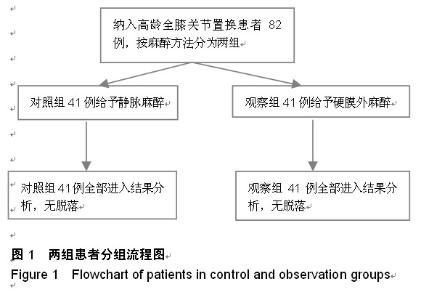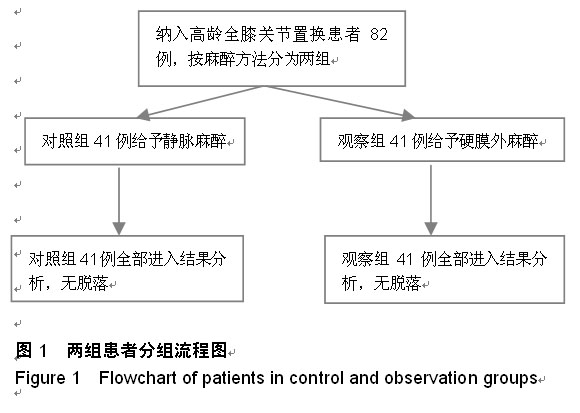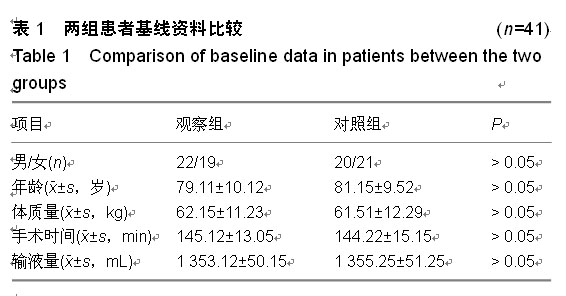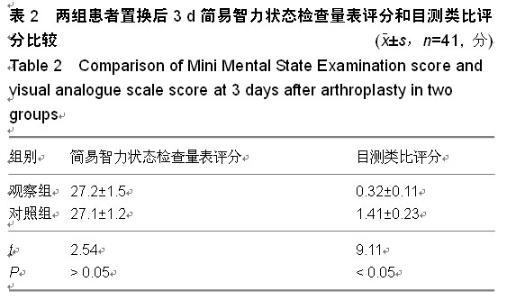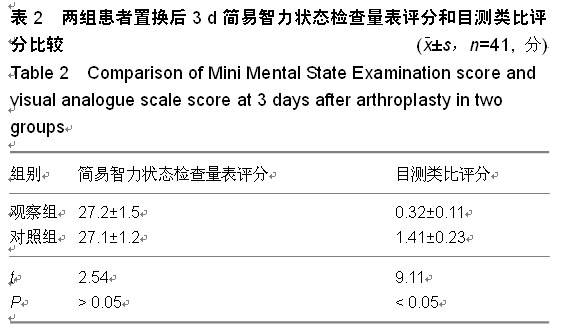| [1] 黄志莲.老年患者术后早期认知功能的改变与血清S-100β蛋白、NSE关系的临床研究[D].温州医学院,2006.
[2] 王准,韩建阁,薛玉良,等.不同麻醉用药对老年非体外循环冠脉搭桥术后认知功能影响的比较[J].天津医药,2010,38(4):291-293.
[3] Clive B, Emma J, Nathan G, et al.Correction: Optimised Anaesthesia to Reduce Post Operative Cognitive Decline (POCD) in Older Patients Undergoing Elective Surgery, a Randomised Controlled Trial. PloS one. 2012;7(6):e37410.
[4] Deo H, West G, Butcher C,et al.The prevalence of cognitive dysfunction after conventional and computer-assisted total knee replacement. Knee. 2011;18(2):117-120.
[5] Postler A, Neidel J, Günther KP, et al. Incidence of early postoperative cognitive dysfunction and other adverse events in elderly patients undergoing elective total hip replacement (THR). Arch Gerontol Geriatr. 2011;53(3):328-333.
[6] 李升文.不同麻醉和镇痛方法对非心脏手术后早期认知功能的影响[J].中国卫生产业,2013,10(12):106-107.
[7] 王建生,李仕国,牟宏宇,等.不同麻醉、镇痛方法对行全关节成形术老年患者术后早期认知功能的影响[J].山东医药,2014,54(21): 81-83.
[8] 盛清明,李华忠,刘轶岚,等.芬太尼静脉镇痛对全髋置换老年患者术后认知功能的影响[J].中国医药指南,2013,11(35):410-410, 411.
[9] 孙威.不同麻醉和镇痛方法对老年患者非心脏手术后早期认知功能的影响[J].医学信息,2014,27(26):569-570.
[10] 蒋宗明,丛昊,仲俊峰,等.硬膜外阻滞对全麻下腹腔镜胃癌根治术老年病人术后认知功能障碍的影响[J].中华麻醉学杂志,2013, 33(9):1056-1058.
[11] 李井柱,李晓征,王晓敏,等.帕瑞昔布钠镇痛对老年急诊股骨头置换术患者神经系统的影响[J].中华医学杂志,2013,93(27): 2152-2154.
[12] 黄志莲,李军,连庆泉,等.老年患者髋关节置换术后早期认知功能障碍的因素分析[J].中华麻醉学杂志,2008,28(3):201-204.
[13] 周丘,刘英,许方荣,等.不同麻醉和镇痛方法对老年患者非心脏手术术后早期认知功能的影响[J].中国医学创新,2014,11(25): 10-12.
[14] Jildenstål PK,Hallén JL,Rawal N,et al.Effect of auditory evoked potential-guided anaesthesia on consumption of anaesthetics and early postoperative cognitive dysfunction: a randomized controlled trial. Eur J Anaesthesiol.2011;28(3): 213-219.
[15] 王哲银,王定一,任永功,等.不同术后镇痛方法对老年患者认知功能的影响[J].中国临床实用医学,2010,4(2):1-2.
[16] 王志波,范英龙,王海,等.超高龄患者下肢骨科手术麻醉方法的选择与比较[J].浙江实用医学,2013,18(3):162-164.
[17] 周小燕,巫秀珍.麻醉与老年患者术后认知功能障碍的相关研究[J].河北医学,2013,19(6):801-805.
[18] 李骥,邱继忠,苏忱,等.小剂量吗啡伍用局麻药行椎管内麻醉对老年患者术后认知功能影响的观察[J].中国冶金工业医学杂志, 2007,24(4):413-415.
[19] 黄建忠,韩全国,刘永宏,等.瑞芬太尼镇痛对老年人腹腔镜手术患者术后早期认知功能的影响[J].海南医学,2011,22(20):14-16.
[20] 张大志,王东信,穆东亮,等.单次坐骨神经联合连续股神经阻滞镇痛对膝关节置换术后谵妄发生率的影响[J].中国药物警戒,2013, 10(4):199-202.
[21] 郑侃.纳美芬超前镇痛对老年关节置换术后患者早期认知功能的影响[J].中国医药导报,2012,09(20):58-59.
[22] 熊雄,熊双宝,周德祥,等.盐酸氢吗啡酮和吗啡PCEA对高龄患者术后认知功能的影响[J].医学信息,2014,27(33):54-55.
[23] 郑羡河,蒋宗明,张昌锋,等.帕瑞昔布钠超前镇痛对老年病人术后认知功能的影响[J].中华麻醉学杂志,2011,31(3):310-312.
[24] 贺纯静,聂浩雄,郭春芮,等.氟比洛芬酯术后镇痛对老年髋关节置换术患者术后认知功能的影响[J].临床麻醉学杂志,2013,29(1): 13-15.
[25] 曾德亮,陈静,张笃文,等.连续股神经阻滞镇痛对老年人全膝关节置换术后早期认知功能的影响[J].贵阳医学院学报,2014,39(3): 365-368.
[26] 范英龙.多模式镇痛对老年骨科手术患者术后认知功能障碍的影响[J].中国医师进修杂志,2014,37(21):49-51.
[27] 吴树宁.腰-硬联合阻滞麻醉对髋关节置换术患者血流动力学和认知功能的影响[J].陕西医学杂志,2013,42(7):874-875.
[28] Zywiel MG, Prabhu A, Perruccio AV, et al. The Influence of Anesthesia and Pain Management on Cognitive Dysfunction After Joint Arthroplasty: A Systematic Review.Clin Orthop Relat Res. 2014;472 (5):1453-1466.
[29] 朱永锋,孟凡民.右美托咪啶对体外循环下瓣膜置换术后患者认知功能改变的影响[J].中华胸心血管外科杂志,2014,30(7): 404-407.
[30] 钱怡宁,张茁,孟旭,等.心内直视手术患者围术期认知功能的变化[J].中华医学杂志,2005,85(20):1400-1402.
[31] 袁东彬,杨武,赖峰,等.不同麻醉方法对老年患者非心脏手术后早期认知的影响[J].中国现代药物应用,2013,7(3):49-50.
[32] 周小燕,巫秀珍.麻醉与老年患者术后认知功能障碍的相关研究[J].河北医学,2013,19(6):801-805.
[33] 李骥,邱继忠,苏忱,等.小剂量吗啡伍用局麻药行椎管内麻醉对老年患者术后认知功能影响的观察[J].中国冶金工业医学杂志, 2007,24(4):413-415.
[34] 王哲银,王定一,任永功,等.不同术后镇痛方法对老年患者认知功能的影响[J].中国临床实用医学,2010,4(2):1-2.
[35] 黄志莲,李军,连庆泉,等.髋关节置换术老年患者血清IL-6水平与术后早期认知功能障碍的关系[J].浙江临床医学,2008,10(4): 445-446.
[36] 付春梅,杨少辉,黄明理,等.老年人髋关节置换术后认知功能障碍的研究[J].中国实用医药,2011,6(36):28-29.
[37] 吴越,孙德峰,苗壮,等.布托啡诺超前镇痛对老年人全髋关节置换术后早期认知功能的影响[J].中国医药指南,2013,11(1): 447- 448.
[38] 王世英,孔玲,毕光焰,等.硬膜外镇痛与静脉镇痛对老年下肢关节置换及植入物内固定治疗后早期认知功能的影响[J].中国组织工程研究与临床康复,2011,15(35):6514-6517.
[39] 孙德峰,杨林,于湛,等.硬膜外隙预注小剂量吗啡超前镇痛对高龄患者术后认知功能的影响[J].中国医药指南,2012,10(33):60-62.
[40] 潘丽峰,王东信,李军,等.不同麻醉和镇痛方法对老年患者非心脏手术后早期认知功能的影响[J].北京大学学报(医学版),2006, 38(5):510-514. |
